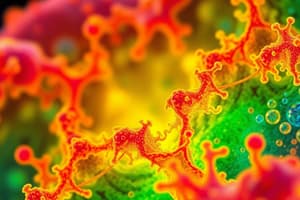Podcast
Questions and Answers
What is the primary role of the cell membrane?
What is the primary role of the cell membrane?
- Store genetic information for the cell.
- Generate energy for cellular functions.
- Regulate the passage of materials into or out of the cell. (correct)
- Provide structural support to the cell wall.
What structural feature describes the kidney of the cell membrane as viewed with an electron microscope?
What structural feature describes the kidney of the cell membrane as viewed with an electron microscope?
- Tessellated pattern.
- A single dark line.
- Bulbous formations.
- Trilaminar with two dark lines and one light line. (correct)
Which component of the cell membrane contributes to its stability and rigidity?
Which component of the cell membrane contributes to its stability and rigidity?
- Glycocalyx.
- Phospholipids.
- Cholesterol. (correct)
- Integral proteins.
Which type of protein is embedded within the lipid bilayer and functions as a channel for water-soluble substances?
Which type of protein is embedded within the lipid bilayer and functions as a channel for water-soluble substances?
What describes the function of the cell coat, also known as the glycocalyx?
What describes the function of the cell coat, also known as the glycocalyx?
What type of transport involves the engulfing of solid particles by the cell membrane?
What type of transport involves the engulfing of solid particles by the cell membrane?
Which staining method is specifically associated with visualizing the carbohydrate components of the cell membrane?
Which staining method is specifically associated with visualizing the carbohydrate components of the cell membrane?
What is the primary composition of the lipid bilayer in the cell membrane?
What is the primary composition of the lipid bilayer in the cell membrane?
What is the primary focus of histology?
What is the primary focus of histology?
Which structure is considered a membranous organelle?
Which structure is considered a membranous organelle?
What color does Hematoxylin stain appear under a microscope?
What color does Hematoxylin stain appear under a microscope?
Which of the following microscopy techniques allows the highest level of magnification?
Which of the following microscopy techniques allows the highest level of magnification?
How does the structure of a lysosome correlate with its function?
How does the structure of a lysosome correlate with its function?
Which of the following stains are specifically used to identify carbohydrates in histological sections?
Which of the following stains are specifically used to identify carbohydrates in histological sections?
What is one of the components of the cytoplasm?
What is one of the components of the cytoplasm?
Which of the following organelles is classified as non-membranous?
Which of the following organelles is classified as non-membranous?
Flashcards are hidden until you start studying
Study Notes
Histology
- The study of the normal microscopic structure of cells (cytology) and tissues in relation to their functions.
- Hierarchy: Cells → Tissues → Organs → Organisms
Staining
- Differentiation of various structures by taking different colors.
- Types:
- Acidic:
- Eosin (E): Pink
- Hematoxylin & Eosin (H&E): Purple
- Basic:
- Hematoxylin (H): Blue
- Acidic:
Special Stains
- Carbohydrates:
- Periodic Acid Schiff (PAS): Magenta
- Lipids:
- Frozen sections are used.
- Sudan III: Orange
- Sudan Black: Black
- Osmic acid: Black
The Microscope
- Magnifies images to reveal details of the object.
- Types:
- Light microscope: 40, 100, 400, 1000 times magnification
- Electron microscope: Up to 50,000 times magnification.
- Transmission EM
- Scanning EM
Structure of the Cell
- Cell membrane: Surrounds the cell and regulates material passage.
- Cytoplasm: Contains:
- Cytosol (cytoplasmic matrix)
- Cell organelles
- Cell inclusions
- Nucleus
Cell Organelles
- Living components in the cytoplasm
- Types:
- Membranous:
- Cell membrane
- Mitochondria
- Endoplasmic reticulum (smooth and rough)
- Golgi apparatus
- Lysosomes
- Non-membranous:
- Ribosomes
- Cytoskeleton
- Microtubules (as centriole, cilia)
- Filaments (Thin, intermediate, & thick)
- Membranous:
The Cell Membrane
- The outer limiting membrane that surrounds the cell.
- Light microscope (LM): Too thin to be seen, but its carbohydrate contents can be stained by PAS.
- Electron microscope (EM): Trilaminar structure: two dark (electron-dense) lines separated by a light one (electron-lucent).
- Called unit membranes
Chemical Structure
- Lipid:
- Phospholipid
- Cholesterol
- Protein:
- Integral (intrinsic protein)
- Peripheral (extrinsic protein)
- Carbohydrate:
- Cell coat (Glycocalyx)
Lipid Structure
- Phospholipid double layers:
- Hydrophilic polar head (outwards)
- Hydrophobic non-polar tail (center)
- Cholesterol: Located on the cytoplasmic side of the lipid bilayer, giving stability and rigidity to the membrane. It forms channels for lipid-soluble substances.
Integral Protein
- Located within the lipid bilayer and not easily extracted.
- Small particles: Partially embedded in the lipid bilayer.
- Trans-membranous protein: Large in size, completely embedded in the lipid bilayer and crosses it. It acts as channels for water-soluble substances.
Peripheral Protein
- Located on the periphery and loosely attached to the outer surface of the cell membrane.
- Easily extracted.
Carbohydrate Component
- Consists of glycolipids and glycoproteins.
- Projects from the external surface of the membrane, forming the:
- Cell coat or Glycocalyx:
- PAS positive
- EM: Fuzzy appearance
- Thick in the intestine
- Cell coat or Glycocalyx:
Functions of the Cell Membrane
- Maintains the internal composition of the cell.
- Cell coat (glycocalyx) functions:
- Attachment to other cells:
- Receptors:
- Cell-to-cell recognition:
- Immunity:
Bulk Transport
- Exocytosis:
- Endocytosis:
- Phagocytosis:
- Pinocytosis:
MCQ
- The cell coat is:
- Well developed and thick in the intestine.
- How the cell membrane appears by EM:
- Trilaminar.
- Which substance of the following is responsible for decreasing lipid bilayer movement?
- Cholesterol molecule.
- Which of the following stains is responsible for staining of the cell membrane?
- PAS.
Studying That Suits You
Use AI to generate personalized quizzes and flashcards to suit your learning preferences.



